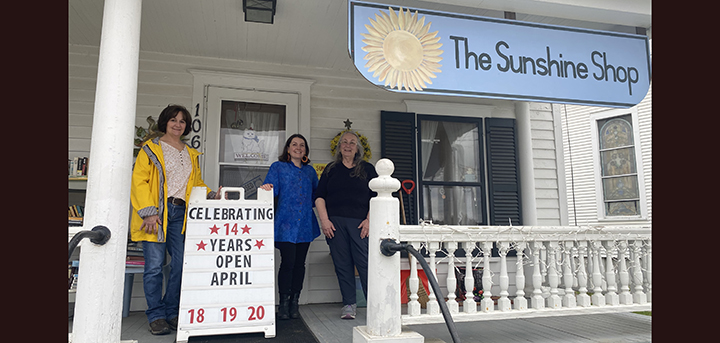Project Chenango: Chenango's Working Poor
Published:
September 3rd, 2015
By Melissa Stagnaro
Special to The Evening Sun
stagnaro.melissa@gmail.com
* “Diane” is a divorced single mother of three girls living in the City of Norwich. When she agreed to share her story with The Evening Sun’s readers, she asked that her name be withheld out of deference to her school-aged children. Because of the importance of this story, The Evening Sun has complied with that wish.
CHENANGO – Diane* was 17 when she joined the workforce.
“I’ve been working ever since,” said the City of Norwich resident, now 40. She’s never considered doing otherwise.
“You go out and work and earn your money. That’s how it’s supposed to be.”
With that work ethic, it never crossed her mind there might be a day when she wouldn’t be able to support herself. Yet that’s the situation she found herself in 11 years ago.
At the time, Diane was finishing up her degree and had just started a new job when she discovered she was pregnant.
“My husband wasn’t working,” she said. Her income simply wasn’t enough to cover their expenses, especially since she was still waiting to enroll in the health insurance offered by her new employer. “I needed to get some help with food so we could pay the bills.”
It wasn’t an easy decision.
“I remember thinking, I shouldn’t have to do this,” she recalled. “I didn’t want assistance.”
Diane, now divorced, supports herself and her three daughters on her single income. Even working 40 hours a week at a wage of $15 an hour, ends don’t meet. She considers herself luckier than others in her situation because she qualifies for the SNAP program.
Even then, it’s difficult.
“I receive $274 a month in food stamps for a family of four,” she explained. That’s her food budget for the month. In order to stretch it as far as she can, she goes to BJ’s, where she buys as much as she can in the hopes of filling her freezer. The only other money she has to spend on food is the roughly $50 a week she sets aside from her paycheck. That must cover any extra food, plus the lunches she brings to work.
As for what she buys, Diane hates the stereotypes about what people buy with food stamps.
“I’m not buying steak and lobster, that’s for sure,” she said. Luxury items aren’t in the budget when she’s trying to stretch her monthly food allowance as far as it will go.
She will occasionally buy fish.
“If it’s on sale, I’ll buy it because it’s a good source of nutrition and good for my family,” she said. “I get looks for that.”
Diane carefully budgets each month, accounting for every dollar she spends.
“You have to be creative about it,” she said.
With food prices high – and back-to-school expenses to consider – Diane is looking into Food Sense for a little extra help. This program, run by the Food Bank of Central New York, offers a discounted bundle of food each month for around $16. It’s available locally through Roots & Wings in Norwich and First Baptist Church in South New Berlin.
She also took advantage of the recent Greater Chenango Cares IRT program to have both her and her oldest daughter’s teeth cleaned.
Sometimes, no matter how carefully Diane budgets, there simply isn’t enough money to go around. That’s when she has to make tough decisions about what bills get paid and what they will need to do with out.
“We’re always going to have the lights on and a roof over our heads,” she said, explaining that the mortgage and electric bill always get paid first. This, though, gets difficult during heating season, when her electric bill can more than triple – from $100 a month to as much as $350. During a month like that, the credit card bill may not get paid.
This last winter stretched her budget – and her creativity – to the max.
“It got tight around March when it was still cold,” she explained. “Thank God I got my tax return or bills wouldn’t have gotten paid.”
As she commutes more than 10 miles each way to work each day, she closely watches the price of gas and adjusts the family’s activities accordingly. When gas prices were high, extra trips were out unless they could ride with a friend.
“There were things we couldn’t do because I needed to save that [gas] for work,” she said.
Sometimes home repairs also need to wait.
“A lot of times I need to wait for my tax refund,” she explained. With a number of necessary projects, she has to be strategic about what she crosses off the list first. “It’s one step at a time.”
Diane does have a credit card, but she saves it for emergencies.
“I try not to go that route if I can help it,” she said, explaining that she’s trying to improve her credit score. Better credit will help her refinance her existing mortgage, where she’s paying a 9.6 percent interest rate.
“Homeownership means everything to me,” she said.
Diane is very aware of the example she is setting for her daughters.
“I want my girls to understand that, no matter what adversity you face, you have to work through it,” she said. “Sometimes things don’t work out how you expect them to. You have to have a plan B and then work toward your goals.”
Diane knows that she’s not alone in her situation.
“The cost of living has increased exponentially, where as wages really haven’t,” she said.
She worries that some who need help and might qualify for it are either afraid to or too proud to apply because of the stigma often attached to social services.
“I can understand that,” she said, acknowledging that taking that step was difficult. But she isn’t ashamed of using those services.
“I’m what the system was made for. Do I want to be [on assistance] forever? No.”
A GROWING CONCERN
According to Elizabeth Monaco, Executive Director of the Chenango United Way, Diane is not alone. She is part of a growing population that Monaco and others that work in the human services field often refer to as the ‘working poor’.
“There are a lot of people in need in our county,” the non-profit executive said. She’s not talking about the families that fall below the poverty line, however. She is talking about the growing number of working households that make too much to qualify for traditional types of assistance – often by a very small amount.
“I was really shocked that a large percentage – three quarters or more – of the people we served were working folks, many of them dual-income households, generally insured, but didn’t have enough to make ends meet,” she said, referring to the Greater Chenango Cares IRT.
The ‘working poor’ population is one that has Monaco and her colleagues in the human services world worried.
“There are a lot of people in the community that aren’t making a living wage,” said Monaco.
The problem is that while they don’t make enough to cover the necessities, many that fall into this category make too much – by just a narrow margin – to qualify for traditional assistance programs.
The high overall cost of living and such things as food prices, the price of gas, rising health care premiums, and unpredictable winters are all factors that contribute to the income insecurity of this group, Monaco explained.
Childcare expenses, too, can be difficult for a working family to shoulder. And a lack of chil care options - especially for workers who may work non-traditional hours – can prevent people from accepting jobs that may pay a higher wage, Monaco said.
Another issue is housing, according to Daniel Auwarter, Deputy Commissioner of the Income Maintenance Programs at the Chenango County Department of Social Services.
“Those living near or in poverty may rent because they cannot afford to purchase a home due to credit, income and more recently the housing market bubble and crash,” he said. As a result, they could be spending as much as 30 percent of their income on housing. “…[F]or many families the delicate balance of income and expense becomes a challenge.”
“They’re making it work by the skin of their teeth,” Monaco said. “If one thing happens, the whole house of cards falls apart.”
That one thing could be something major like a missed paycheck or a health crisis, but it could also be a higher than normal cell phone or utility bill, a leaky roof, a car breakdown, etc. Right now – with kids heading back to school, and another heating season fast approaching – those budgets will be getting stretched, putting them at greater risk of falling into crisis, Monaco explained.
It’s hard to quantify the size of this population, in part because there is no real definition of ‘working poor.’
“It’s difficult to put a figure on it, but it is clear that Chenango has a significant population of individuals that are challenged to make ends meet,” Auwarter said.
A SAFETY NET
Those that don’t qualify for services can seek help from a safety net of non-profit programs, many of which receive funding through the Chenango United Way.
“Forty-two percent of our funding - $142,379 of $334,495 – for this year is going to programs that are addressing the needs of the working poor, including programs for after school programming and child care, medical and prescription programs, literacy programs and income tax programs,” Monaco said.
One of those programs is Roots & Wings on Berry Street in Norwich.
“We help everyone and we hear their stories,” said Program Director Melinda Mandeville.
Mandeville says the number of families they see is in the rise. In fact, the influx has put a strain on their resources. As a result, they have had to decrease the number of meals they provide through the food pantry – from 15 meals (the equivalent of 5 days worth of food) to 9 meals (3 days of food). They now also require documentation of how many are in the household. It’s another step to make sure they have enough food to go around.
While the food pantry portion does have income requirements, they will help everyone once regardless of whether they meet that criteria.
“Then we’ll refer them out, not necessarily to food pantries, but wherever they may find help with whatever barriers they are facing.” Those referrals may include Chenango Health Network, The Place, Opportunities for Chenango, and Catholic Charities of Chenango County, of which Roots & Wings is a part.
SETTING THE RECORD STRAIGHT
One of the barriers to people seeking help is often the stigma attached to social services. In Chenango County, this is exacerbated by some widely held beliefs about the Department of Social Services – specifically that it is somehow easier to get services in Chenango County, that the services offered are more generous and that people move to Chenango attracted by these benefits.
Auwarter is eager to set the record straight on these points.
“Chenango’s core social service programs are the same ones that are offered statewide,” he reported. “Our services are ones that are state or federally mandated, and are also regulated by state and federal rules.”
Is it easier to get services in Chenango County?
According to Auwarter, the rules are the same across the board. However, because the volume of clients they see is dramatically smaller than what a larger county sees on a daily basis, clients don’t spend as much time waiting in line.
“Our agency works hard to run efficiently, including the processes we have to get clients in to see the various departments,” he said. “…[w]e don’t generally have people waiting for hours to see a worker.”
As for the residency requirements to receive benefits in Chenango, Auwarter again stressed that this is not something up to the county’s discretion.
“The rules regarding public assistance and residency are set at the legislative level, not locally,” he explained. And according to Social Service law, Chenango – and any district – must provide assistance to anyone eligible to receive benefits whether they legally reside in the county or not.
Auwarter also doesn’t believe that people move to Chenango solely to access benefits.
“People move to other areas for a variety of reasons, but doing so for the sole purpose of getting on public assistance is not a reason, in my experience, that people move to Chenango,” he said.
Are there users of the system who abuse it? Auwarter said yes.
“There are people that try to defraud the system everywhere in the nation, and it does happen in Chenango as well,” he said, “and we use programs, systems and safeguards to prevent this.”
This stigma is exactly why Diane says she wanted to tell her story – even though she knows that in doing so, she may get a negative response from some readers.
“I think it’s important for people to know that not all of us getting help are using the system,” she explained. “There are hard working families out there who use it because they need it.”
Comments






